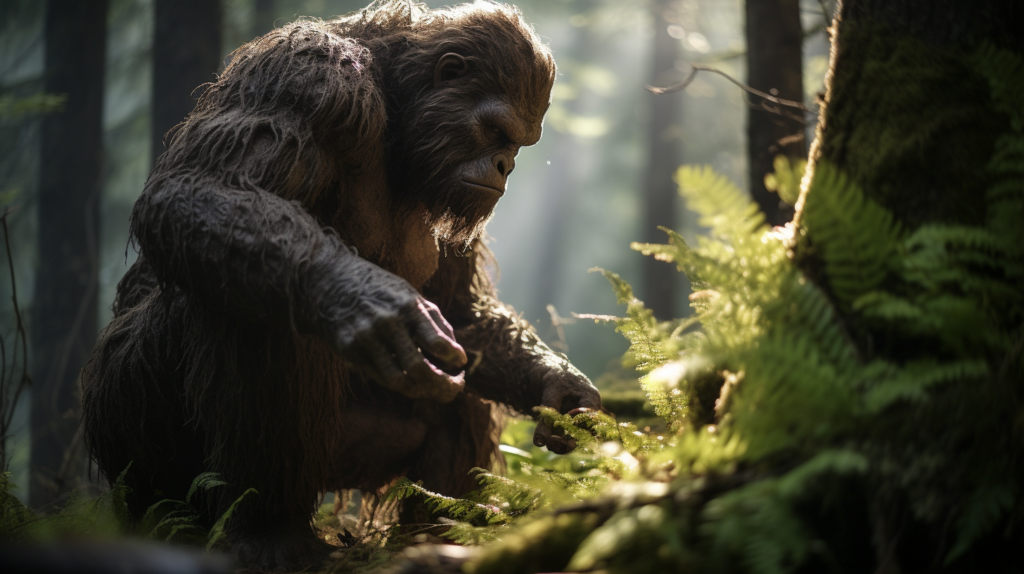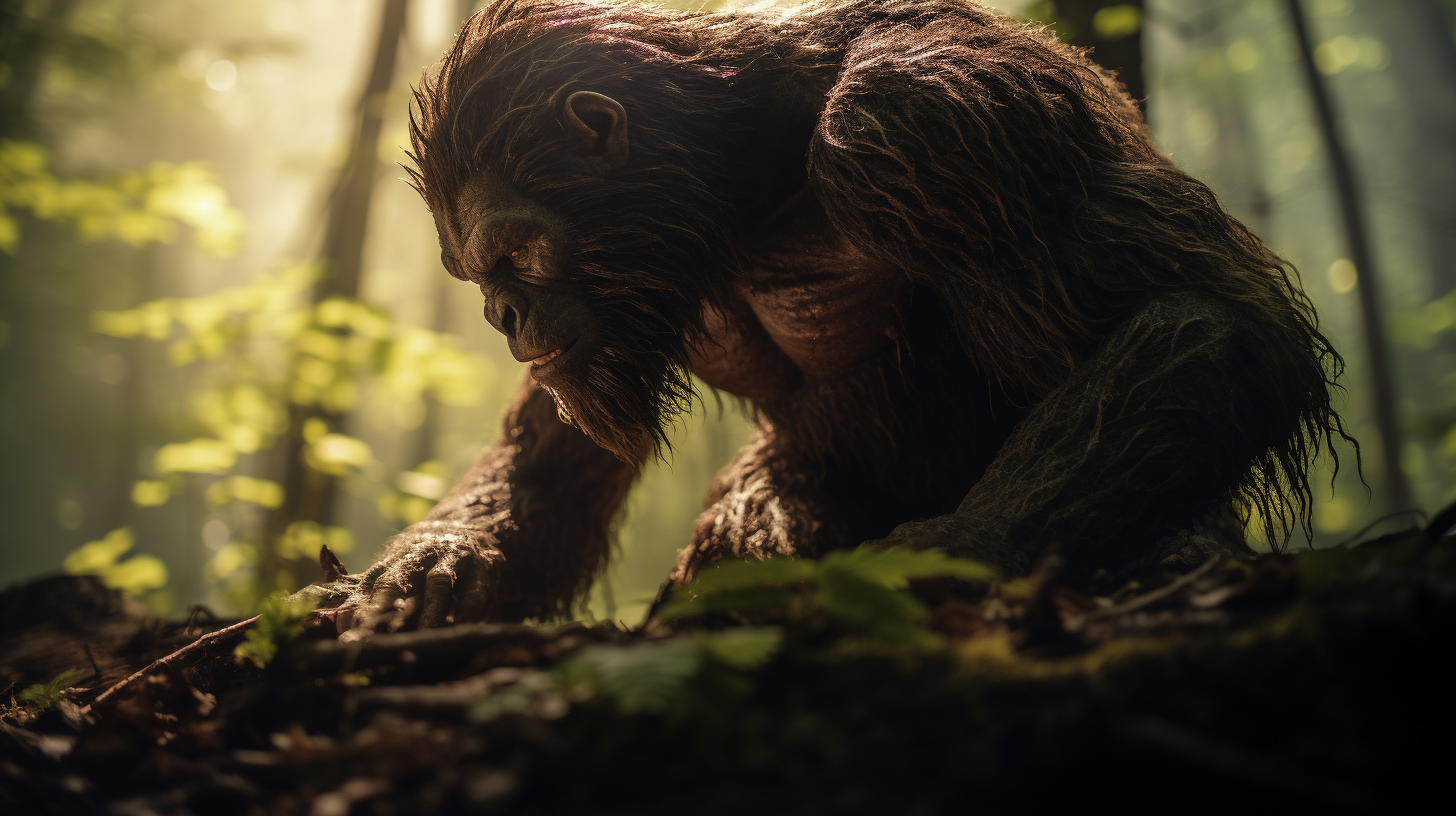The elusive creature known as Bigfoot, also commonly referred to as Sasquatch, has long captivated the imagination of enthusiasts across North America and beyond.
This legendary figure is often depicted as a towering, hairy humanoid wandering the remote forests, and while its existence is hotly debated, the lore surrounding it continues to thrive within the realm of cryptozoology.
One of the more practical questions that arises when discussing Bigfoot is what would such a creature eat to sustain its purportedly large frame and reclusive lifestyle?
Due to the lack of concrete evidence regarding Bigfoot’s existence, theories about its diet are largely speculative, yet they offer interesting insights into the possible ecology of such a creature.
Arguments typically draw from observed behaviors of known animals and anecdotal accounts from those who claim to have encountered the creature.
As Sasquatch is often described with primate-like characteristics, it might be assumed that if they exist, they could be omnivores with a diet similar to that of other large primates.
Explorations into what Bigfoot might eat lead to discussions ranging from the foraging of plants, nuts, and berries to the hunting of small mammals and fish, which would theoretically be necessary to sustain a creature of considerable size.
These food sources are abundant in many of the forested regions of North America where sightings are commonly reported. The subject remains a fascinating aspect of the Bigfoot saga, providing yet another layer to the enigma of this famed legend.
Historical Context and Sightings
Exploring Bigfoot’s historical context and sightings provides insight into the enduring legend of this cryptid. Through traditional folklore, pivotal encounters, and its role in cryptozoology, we deepen our understanding of what people believe Bigfoot may eat and how these beliefs came to be.
Origins and Traditional Folklore
The Bigfoot phenomenon has deep roots in various Native American legends, particularly those of tribes in the Pacific Northwest. Descriptions of large, hairy creatures akin to Bigfoot are widespread in indigenous stories across regions including Oregon and Northern California. These creatures are often depicted as powerful beings connected to the earth, with diets rooted in the region’s rich natural resources.
Famous Bigfoot Encounters
One of the most notable sightings was captured in the Patterson-Gimlin film, shot by Roger Patterson and Bob Gimlin in 1967 in Northern California. The film shows an ape-like creature, and the image has become synonymous with Bigfoot. Although its authenticity has been hotly debated, it sparked a surge in reported sightings and interest in the Bigfoot legend.
Role in Cryptozoology
In cryptozoology, a field of study involving the search for animals whose existence is unverified, Bigfoot holds a prominent place. Expedition Bigfoot, among others, demonstrates the ongoing quests to find evidence of its existence, whether through footprints, photographs, or eyewitness accounts. Noted researchers like Ronny Le Blanc continue to analyze historical and modern encounters, despite some claims being revealed as hoaxes.
Anatomical and Behavioral Theories
Bigfoot, often compared to bears and primates in physicality, has a set of features that might give insight into its diet. Analyzing Bigfoot’s anatomy and behavior could provide a window into the creature’s eating habits and lifestyle.
Physical Features and Comparison with Other Animals
Bigfoot is reported to have large footprints and footprint casts, similar in appearance to giant apes like Gigantopithecus, an extinct genus of ape from historical Asia.
The hair samples thought to be from Bigfoot have not provided conclusive DNA evidence, but many hypothesize that, like bears, its strong limbs could be adapted for foraging. The suspected claws or nail structures might indicate a capability to dig and grasp, traits common in omnivores.
Possible Diet Based on Habitat and Anatomy
Given Bigfoot’s purported habitat in the forests of North America, as discussed by sources like the North American Bigfoot Center, it would likely encounter a variety of animals, such as salmon, deer, and elk. Its robust physique suggests a diet that includes meat.
However, its environment also offers berries, nuts, fruits, leaves, and other plant materials that would be accessible to a large omnivorous creature.
Behavioral Patterns and Evidence
Evidence such as makeshift nests, use of rocks for tools or marking territory, and observational data from programs like Animal Planet’s Finding Bigfoot, indicate a complex set of behaviors.
These suggest Bigfoot may have advanced foraging methods, utilizing both plant and animal resources akin to known omnivores. Reports and sightings often involve Bigfoot in the act of consuming or searching for food, aligning with the idea that they have a varied diet.
Scientific Investigations and Skepticism

The quest to understand Bigfoot’s diet has led to various scientific investigations, drawing the attention of both ardent cryptozoologists and rigorous skeptics. While some seek verifiable evidence using the scientific method, others challenge the validity of the claims presented.
Analysis of Physical Evidence
Physical evidence such as purported Bigfoot feces, hair, and remnants of feeding have been analyzed to discern dietary habits.
Skeptical Inquirer Magazine often emphasizes the importance of empirical evidence that can withstand scientific scrutiny. When claimed Bigfoot evidence is examined, items like hair are often subjected to microscopic analysis by entities such as the FBI’s Scientific and Technical Services Division. However, without a verified specimen for comparison, results can be inconclusive.
DNA Studies and Biological Insights
Cryptozoologists sometimes assert that analyses such as mitochondrial DNA testing can offer insights into Bigfoot’s existence and by extension, its diet.
There have been attempts to study alleged Bigfoot DNA, with some studies published in sources like the Proceedings of the Royal Society B. Despite these efforts, many in the scientific community remain skeptical due to methodological concerns and the lack of peer-reviewed confirmation.
Critiques and Challenges in Cryptozoological Research
Criticism of Bigfoot research often focuses on the lack of adherence to the scientific method and the rarity of conclusive scientific evidence.
While the Bigfoot file may contain numerous reports, they often fail to translate to verifiable data. The challenge for cryptozoologists is to produce evidence that stands up to the rigor of established scientific paradigms, overcoming the skepticism that envelopes cryptozoological research.
Cultural Impact of Bigfoot
Bigfoot has permeated various aspects of culture, notably in media, regional identity, and environmental discourse. It stands as a symbol that bridges folklore and pop culture, often spotlighting environmental conservation.
Bigfoot in Media and Entertainment
Bigfoot, or Sasquatch, has been a staple figure in media and entertainment, spanning films, television, and other forms of popular culture.
In film, Bigfoot takes center stage in narratives exploring the unknown, exemplified in The Life and Times of a Legend. Television has embraced the creature in documentaries and dramas, with the image of Sasquatch ranging from a mysterious wildman to a misunderstood being.
- Notable Appearances:
- Films: “Harry and the Hendersons”, “Bigfoot’s Wild Weekend”
- TV Shows: “Finding Bigfoot”, “Bigfoot: The New Evidence”
The Influence on Regional and Pop Culture
Bigfoot’s presence is particularly pronounced in North America, especially in Western Canada, and has influenced regional culture significantly.
Andrew Genzoli of the Humboldt Times was instrumental in popularizing the name ‘Bigfoot’. Festivals, merchandise, and tourist attractions often celebrate or capitalize on the Bigfoot legend, affirming a local identity that is both unique and commercially viable.
- Regional Celebrations:
- Sasquatch Days in Harrison Hot Springs, Canada
- Bigfoot Daze in Willow Creek, California
Contribution to Wilderness and Environmental Narratives
As an icon of the unknown, Bigfoot—related to the Yeti of the Himalayas and Yowie in Australia—has contributed to narratives that emphasize the vastness and the mystery of the wilderness.
It brings attention to the need for environmental conservation, reminding people of the undiscovered species that may inhabit the Earth alongside humans and the importance of preserving their habitats.
- Conservation Themes:
- Mystery and conservation in “The Legend of Boggy Creek”
- Environmental activism seen in Bigfoot research organizations
Frequently Asked Questions
Exploring the mysteries of Bigfoot’s diet draws from a combination of eyewitness accounts, theoretical biology, and comparisons with known primates. This section aims to address some common inquiries regarding the elusive creature’s eating habits.
What kinds of food is Bigfoot thought to consume in the wild?
Bigfoot is generally believed to be omnivorous, with a diet potentially including plants, nuts, fruits, and small animals. The specific foods within its diet are a matter of conjecture, but it’s suggested that, like other primates, it would have a varied diet to meet its nutritional needs.
Are there any documented accounts of Bigfoot’s eating habits?
While there are no scientifically documented accounts, there are anecdotal reports and folklore describing Bigfoot eating berries, fish, and deer, among other things. However, these accounts are not verified by empirical evidence.
How does Bigfoot’s presumed diet compare to known primate diets?
If Bigfoot exists and is a primate, its diet might be similar to that of other large primates, like the gorilla or orangutan, which are primarily herbivorous but also consume insects and small animals.
What evidence, if any, is there to support theories about what Bigfoot eats?
Evidence supporting Bigfoot’s diet is largely circumstantial, such as supposed footprints near berry bushes or accounts of overturned logs, possibly in search of insects or grubs. However, direct proof like fecal samples that can be definitively attributed to Bigfoot is lacking.
Do Bigfoot sightings include observations of it feeding or looking for food?
Some Bigfoot sightings have reported the creature foraging, such as berry picking or fishing in streams. These observations add to the theories about what Bigfoot might eat, but remain anecdotal.
Has there been any research into the nutritional needs a creature like Bigfoot might require?
Research on Bigfoot’s nutritional needs is speculative since the existence of the creature is not scientifically established. However, based on the size and traits often attributed to Bigfoot, researchers have posited it would require a diet capable of sustaining a large, active mammal.

